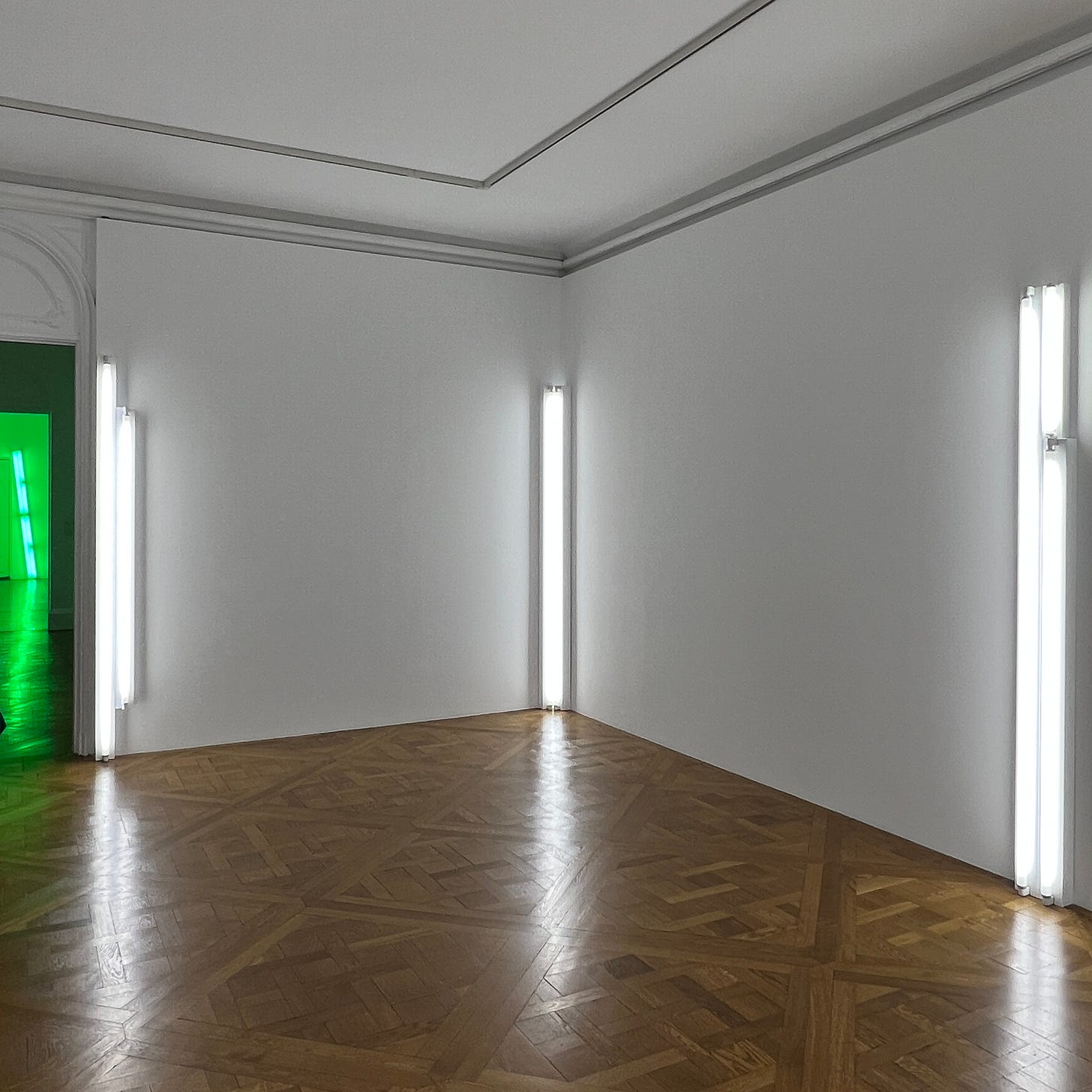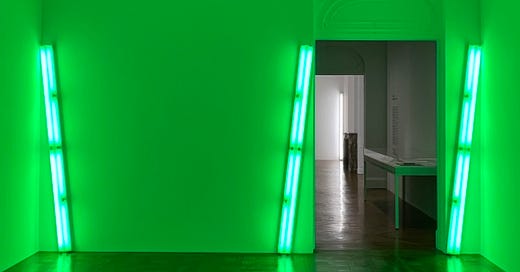
Installation view of The Kornblee Gallery, 1967 by Dan Flavin
Back in the early 80s, I rented a room in Berlin from a nice guy my age who smiled a lot. His English was as rudimentary as my German, plus he mumbled, so we hardly ever spoke. Lost to me is his name, but I remember him as a good-natured slob. Given my experience of Germans, that must have been a bid for originality. The kitchen, for example, was too discouraging to use. The hallmark of his eccentricity was a fluorescent fixture that leaned upright into a corner of his room with its beaux-arts moulding. In the evenings, it was his sole source of light and a cruel white. Despite the opportunities, I rarely went in there, mainly because of that fluorescent. It created a harsh and eerie ambiance that weirded me out. Who puts fluorescent lighting in his bedroom?
A whole two days after seeing the beautiful early Flavin show at Zwirner uptown, I was gripped by the Proustian flashback. Almost forty years later, I finally realise that my mute Berlin roommate was an aesthete, albeit unorthodox, who had made himself a Dan Flavin. There was a hardware store down the street, so nothing could have been simpler. Why it took me so very long to catch the reference is inexplicable. I had a degree in art history by then and had been familiar with the many Flavins at the National Gallery of Canada since my teens. The only explanation is that context counts for an awful lot in art, a crucial point made over and over again by Flavin and his cohort.
Or maybe it’s one of those flawed memories. Perhaps I did get the Flavin reference at the time, but the skimpy intercourse with the roommate, along with his ghastly kitchen habits, repressed it, leaving the episode bereft of beauty. Ironically, Dan Flavin’s work is among the purest forms of beauty I know. Seeing it is to bathe in an unaccountably mystic light and to understand that rigor is invention’s dearest friend.

Preparatory Drawings for Kornblee Gallery, 1966-67 by Dan Flavin
An Irish Catholic from Queens, Flavin had initially planned to become a priest for which he trained in a Brooklyn seminary from 1947 to 1952. He changed his mind. During an interim stint in the air force, he began immersing himself in the study of art while still based in Korea. I’ve known a few almost priests but none whose spiritual novitiate was parlayed into the production of great art. Maybe I’m going out on a limb here, but to me Flavin’s work can be read as an act of industrial redemption.
Where energy efficiency and longevity are concerns, incandescent lamps can’t hold a candle to fluorescents. Aesthetically, though, there’s no contest. Fluorescent light is cold, unflattering, hostile to shadows and generally soulless. I’ve hated every single classroom, office and warehouse lit by them that I was forced to endure. Perniciously, you get used to their hellish glare and only realise that you’d been suffering in the unholy realm of charged mercury vapours when you emerge into the blessedness of sun or moonlight. To make art, Flavin concentrated exclusively on these aesthetically void industrial tubes. In my view, he achieves nothing short of transubstantiation. To say that his exquisitely spare and lucid arrangements of glowing industrial tubes redeems their technology is to not say enough.
I was glad to see Flavin’s preparatory sketches among the archival treasures on display in this show. Arrangements of black bars incongruously representing bars of light, they clarify his practice as a composer of manufactured components. Looking at the elongated marks, I flashed on Giacometti and what his sculptures might have been like had he abandoned the figure. Tightly calligraphic, like words in a reductivist code, they made me think of a hyper-stylised Korean typeface seen sideways, or of chromosomes. In the same vitrine, there are excerpts from Flavin’s journals where he grumbles mildly about the work’s negative critical reception and the ribbing of his artist colleagues at the Kornblee openings. As we well know from art history, magic can take a while to sink in.

Installation view of The Kornblee Gallery, 1967 by Dan Flavin
Flavin had two shows at Kornblee in ‘67. They were markedly different and gain a lot from being seen together in the larger, but architecturally similar Zwirner space ten blocks south. The first show, related to the little sketches above, is in a bright, chilly white. The fixtures are attached flush to the wall in strictly vertical eight-foot lengths like simplified fasces. For the second show, the fixture combinations were in green; they lean into corners at precisely the same angle. To me, they’re extremely schematic depictions of trees tilting at the water’s edge to take full advantage of the extra sunlight. I read the white room as the rational space of ‘man,’ the green room as the opportunistic space of nature. Separated in time at Kornblee, the first show summons the marble heroes of the Western tradition, from the Greeks to Thorvaldsen, made white by circumstance or inclination. The second room puts me in mind of the Romantic landscape idiom, the pure one devoid of human presence from Rousseau to Hudson River. Shown in adjacent rooms here, forgive me for thinking of conjunctive Poussin. Yes, these are prototypically minimalist works, the non-referential movement that claims Flavin as a paradigmatic exponent, so shame on me.
Flavin was not the artist of light, he was the artist of artificial light. The distinction is important and justifies his stature in the epic pageant of the artificial we call art history. We must include Flavin in this multi-millenial story and I suspect that he knew that. Although I never met him and have no notion of his personality, my guess is that he was generous. Although his writing can be idiosyncratic and hard to follow, the identifying subtitles of his consistently untitled works are simple, earnest dedications to his heroes, to his friends and to those who had given him a hand. By the evidence of this exhibition, 1967 was a breakthrough year for Flavin, just before he began the practice of immortalising others. It’s fitting that we remember these works with a nod to Jill Kornblee who made that year happen.



